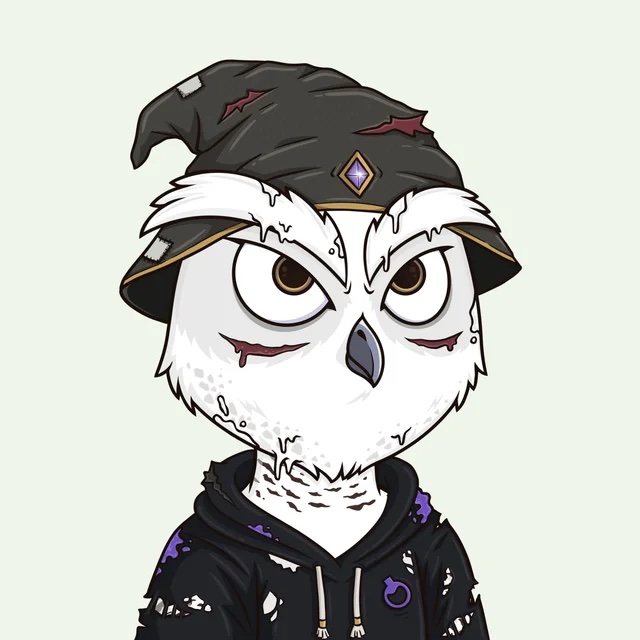NFT Profit Sharing As Utility: A Hypothetical Case Study with VeeFriends
October 6, 2022 - 10 min read
This article analyzes the potential benefit of NFT profit-sharing if it were legal, using VeeFriends as a case study. I also dive into why the Toys "R" Us toy collab for VeeFriends should be celebrated by holders.

Profit-sharing.
It’s one of the most debated NFT utilities that creators can’t legally deliver to project holders.
Not directly at least.
To get around this and bring holders value, NFT project creators have done airdrops (free NFT sent to the addresses of holders for a particular project), events, merchandise (clothing, toys, etc.), mint passes (the ability to mint an NFT of a project by being a holder of another), access to specific events, and more.
Not everyone realizes that creators can’t legally promise profits from their work on an NFT project and it’s one of the biggest mistakes people make when buying an NFT.
It’s unclear if NFTs will ever be deemed securities, which would open the door for direct profit-sharing.
Note — I am not a lawyer and this is not intended to be legal advice, nor it is intended to be financial advice.
And that puts NFT creators, as well as holders, in an interesting position:
(1) NFT mints generate initial sums of revenue, but creators rely on a smaller % of secondary sales for continued revenue generation
(2) If a mint sells out and holders have high expectations, the project creators need to balance using the funds to deliver utility with lesser continual revenues from secondary sales
(3) Projects that aim to operate as a true company (like Yuga Labs, VeeFriends, Proof) need to fund overhead costs like payroll and find ways to develop their business without burning through their mint-raised cash
(4) Holders are technically part of a fund-raise but don’t receive equity (ownership) in the project and are seeking value from other avenues
(5) If the creator can’t deliver enough value, secondary sales volume and prices could decline, lessening the funds to execute on value which drives a negative spiral downward
This is a big reason why I think NFT projects like VeeFriends, Yuga Labs and Proof raised investment rounds, and it’s also why I think it is so critical that NFT project founders find ways to generate revenue outside of NFT sales.
In this article, I’m going to cover:
(1) A hypothetical scenario of VeeFriends doing profit-sharing and how much money holders could earn
(2) Why IP-based non-NFT sales are critical to the future success of an NFT project and why as a holder, this is something you should care about and celebrate
Let’s dive in using VeeFriends as an example of what profit-sharing to NFT holders could look like financially.
What Would Happen if VeeFriends Included Profit-Sharing For NFT Holders?
With the announcement that Gary Vaynerchuk’s VeeFriends NFT project partnered with Macy’s and Toys “R” Us to sell toys of the popular NFT characters, I thought it would be a good time to examine what profit sharing could look like for this project.
Before I get into this, remember that it is all speculation.
No one has told me this will happen and could end up never happening if it remains in a grey legal area.
Some people have been wondering if there’s profit sharing on the VeeFriends and Macy’s / Toys “R” Us collab and the answer to that is no.
So, please read this in full and do not start tweeting that VeeFriends will profit share :)
Currently, the only promised utility of VeeFriends has been VeeCon, but Gary V has delivered much more than that through airdrops, free trading cards, collectibles, etc.
VeeFriends is a different NFT project in that the IP is not owned by the holders. You can’t take your VeeFriend and license it to another company for profit or use it in any commercial capacity.
Whereas other projects like CryptoPunks and Bored Ape Yacht Club, granted IP and commercial rights to holders.
IP control is a very smart (and necessary) business move by Gary. He controls the IP and can guide the narrative, cultural relevance, and perception cohesively without thousands of people taking their characters and potentially distorting or negatively impacting the IP.
It’s possible he sources ideas through a very rigid process to incorporate ideas and execution from talented NFT holders, but he and his team would likely oversee that if they chose to do that.
Because a VeeFriends holder can’t sell the rights to their NFT asset or use it commercially, I’m going to speculate on what it would look like if Gary V profit-shared to his holders directly on the deals he does.
We’ll use the Gratitude Gorilla character as an example because it was one of the limited characters selected for the VeeFriends / Macy’s toy collab.
The current floor of a core (20 copies) Gratitude Gorilla is 20.72 ETH, or $28,122.01.
VeeFriends has a 10% royalty fee, so if the Gratitude Gorilla core sold at the floor price today, the project would collect $2,812 of the $28,122 sale.
Right off the bat, the royalties expose three valuable insights:
(1) VeeFriends earns $2,812 in revenue, some of which needs to be directed to overhead to execute IP expansion
(2) The buyer (unless s/he is a pure collector) is expecting the value of the NFT to go up in the future from a collectibility standpoint due to the rising popularity of VeeFriends or to receive close to their purchase price in value
(3) There’s a $20,000 gap in the sale price and what VeeFriends earns and can reinvest into the project
Note: this is likely part of the reason why Gary V and the team raised funds (and yes, macro conditions) to expand the IP without relying on secondary sales.
Now let’s say Gary V decides to profit share on Gratitude Gorilla toy sales to holders (this is not happening, it is an example).
First, Macy’s / Toys “R” Us would either mark up prices or establish a rev-share with VeeFriends, so even though retail prices are $9.99 — $29.99, VeeFriends would receive less than that amount.
You’d also have to consider the cost of goods sold.
Toy margins are said to be around 23.3% to 25.9% per item, but we’ll go conservative with an 18% margin to VeeFriends, which would be $3.59 for the average price of a VeeFriend toy.
Say 1,000,000 units of the Gratitude Gorilla toy sell, generating $3,590,000 in profit for VeeFriends.
Now let’s say they take 1% of profits to share with Gratitude Gorilla holders.
That would be $35,900.
Remember:
There are 40 NFTs of each VeeFriends Series 1 NFT character.
Each Series 1 holder would receive $897.50.
It's possible specs could receive a higher percentage than cores, but this is just an example.
At 3%, holders could receive ~$2,700 for one collectible in one season of sales.
Again, this is purely speculative and is a 1:1 character example (versus distribution of profits to all VeeFriends holders regardless of character sales).
Another way to look at is if VeeFriends as a whole profited $325 million like Pokemon in 2021, a 3% profit share would be $9.75 million, or $950.75 to each of the 10,255 VeeFriends NFT token holders.
Keep in mind, Pokemon had a profit margin of about 20% (dividing net profit into revenue).
To give more references of the potential for VeeFriends, let’s look at the below comps:
(1) Marvel Studios — $4.3 billion in estimated revenue in 2018 from movie ticket sales, merchandise, and licensing fees
(2) Disney — $81.10 billion for the twelve months ending June 30th, 2022 with net income of $3.142 billion for that same time period (3.87% net profit)
Note that Disney has a relatively low-profit margin of 3.87%. Disney is spending “aggressively” on content, marketing, and tech for its streaming, which is currently losing money.
If VeeFriends matched Disney’s net income at $3.142 billion, and 3% of that was distributed to holders, that would leave $94.26 million for distribution.
Across 10,255 VeeFriend Series 1 assets, that would be $9,191.61 per asset.
If VeeFriends matched Disney’s net income at $3.142 billion, and 10% of that profit was distributed to holders, that would be $30,628 per asset.
The distribution % would depend on margin, and the capital required to continue maintaining and growing the IP. In Disney’s case, maintaining theme parks, financing movies, etc.
At that point, if VeeFriends drove as much revenue and net income as Disney and each asset holder was getting 5-figures in dividends, it would be likely that floor prices would skyrocket, generating additional revenue from secondary sales on top of collectibility.
Why IP-Based Non-NFT Sales Are a Major Positive for VeeFriends Holders
Now that we’ve looked at what profit-sharing could look like if it ever happened and VeeFriends reaches the revenue heights of Disney, we need to get back to the current state of the project with the VeeFriends / Toys “R” Us collab.
There was some negativity about “another thing to buy” for the project and not immediate value to the holders, but looking at it this way misses the big picture:
Remember that if you bought a Gratitude Gorilla today for $28,000, VeeFriends only gets $2,800 to reinvest in the project and utility.
But if VeeFriends sells over $3.6 million in Gratitude Gorilla collectible toys, there’s a whole lot more money to reinvest back into the project and its utility to holders.
Collab sales like this effectively decouple the utility from its reliance on secondary sales and are a massive benefit to holders even if it doesn’t seem that way at first glance.
Yes, it’s up to the project founder to use the revenue wisely, but Gary V’s track record speaks for itself.
Many people expressed fatigue of opportunities to pay more money to buy merchandise from NFT projects, but that merchandise is driving expanded awareness and new revenue streams to fill the 90% gap of secondary sale revenue to purchase price, and that’s a big deal.
If a project can’t find ways to be marketable outside of NFTs, it is solely reliant on secondary market sales and thus the project death spiral sets off because less money for utility = lower sales volume = even less money for utility, and so on.
You want your NFT project to be profitable and you want it to come through other revenue-generating avenues outside of NFTs. Cultural relevance and popularity might be enough to keep secondary sales high enough to keep the revenue coming in to maintain that relevance, but that alone is a risky proposition.
Closing Thoughts
It’s very unlikely we will see profit-sharing from NFTs any time soon and founders will be reliant on delivering utility in other ways.
However, if you are buying an NFT outside of art collectibles and historical assets, you’ll want that project to make money so that it can reinvest in the utility and cultural relevance of the project.
Smart project founders are finding ways to build revenue streams that decouple them from NFT secondary sales, which have a wider gap between the purchase price and royalties.
If these NFT projects run out of money, no one will be able to run them full-time and continue to deliver value.
In time, I think this will become much more apparent.
At the end of the day, non-art and non-historical NFT projects have to operate as businesses, whether it’s media, gaming, community, etc. they have to pay founders and team members to maintain and grow what they already have.
This clicked for me and it’s become even more apparent why I think Gary V will succeed with VeeFriends.
But remember, this is not financial advice. Any NFT purchase decisions are yours and yours alone.
The legal structure to enable NFT profit-sharing may never come to be and even if it does, it would likely take decades of IP building to reach Disney level for VeeFriends.
Newsletter
Enter your email address below to subscribe to my newsletter
latest posts





